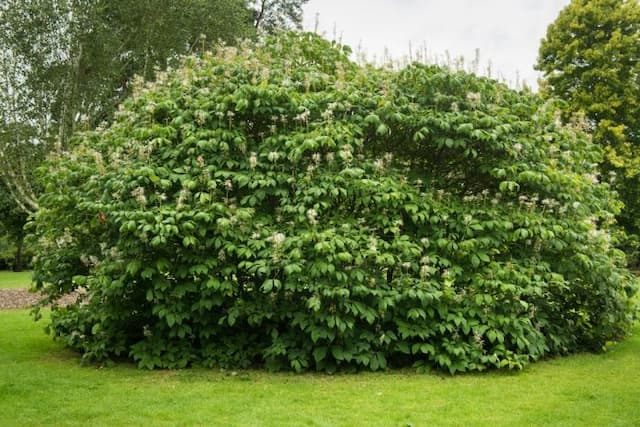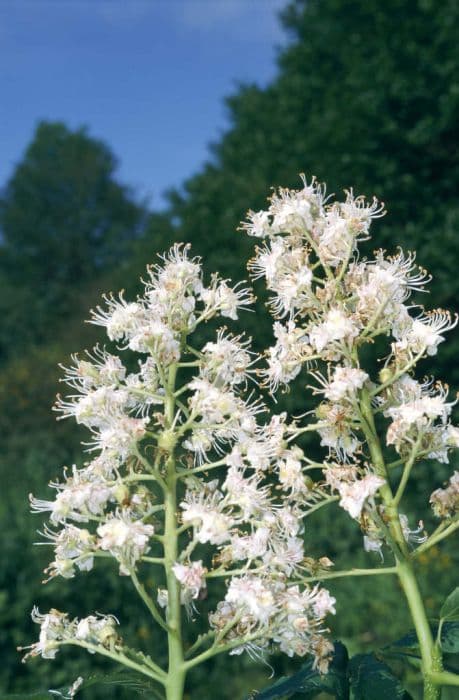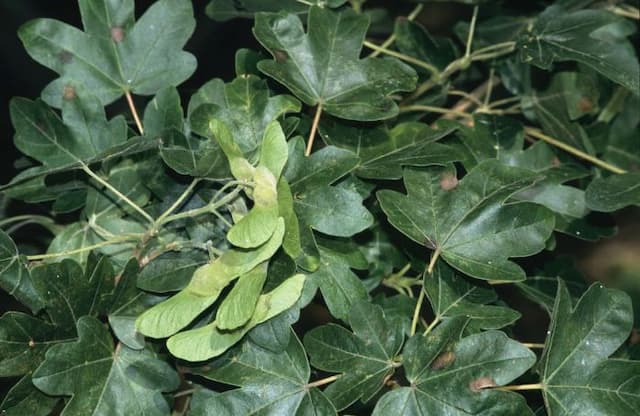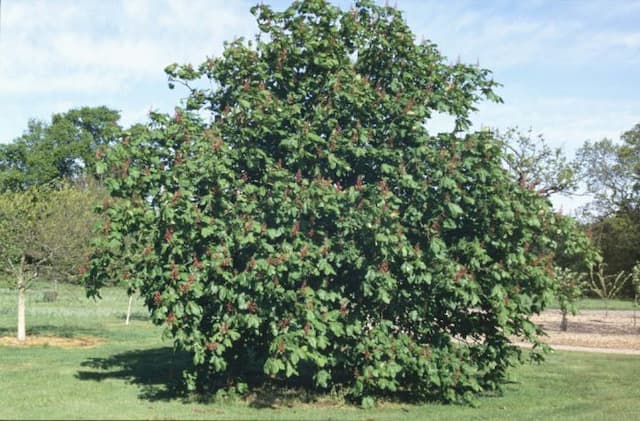Norway Maple Acer platanoides
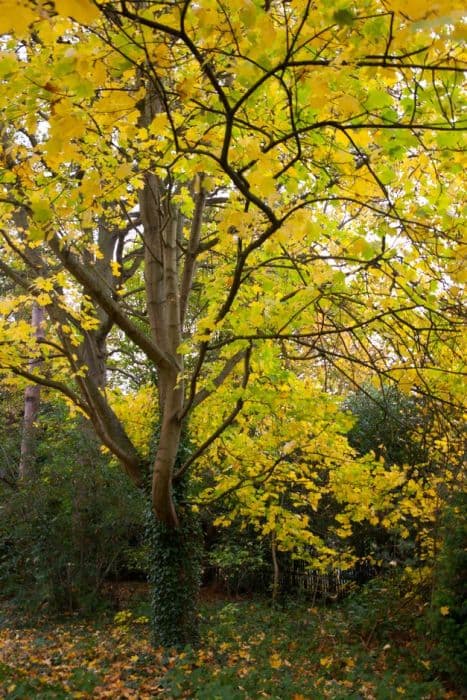
ABOUT
Acer platanoides, commonly known as the Norway maple, is a deciduous tree known for its distinctive foliage and ornamental features. The leaves of the Norway maple are opposite, palmately lobed with 5 to 7 lobes, each lobe sharply pointed and with a few irregular teeth along its margins. The leaves are typically a rich, glossy green, creating a dense canopy of foliage that turns yellow to bright yellow-orange in fall, providing a striking autumn display. The Norway maple produces small, inconspicuous yellow-green flowers that appear in spring before the leaves, arranged in upright clusters. After flowering, the tree develops characteristic winged fruits called samaras. These fruits come in pairs and are slightly flattened, each containing a single seed, and they twirl to the ground like helicopters when they fall. The bark of the tree is grayish-brown and becomes more furrowed with age, providing winter interest with its texture. The Norway maple's crown is generally rounded, and the tree possesses a stout, sturdy trunk. Overall, the Norway maple is appreciated for its shade tolerance and adaptability, which has made it a favored choice in parks and urban landscapes.
About this plant
 Names
NamesFamily
Sapindaceae.
Synonyms
Norway Maple, European Maple.
Common names
Acer hispidum Schwer., Acer lobelii Ten., Acer montanum Andrz. ex Besser, Acer platanoides f. schwedleri (K.Koch) Schwer., Acer platanoides var. laciniatum Rehder, Acer platanoides var. schwedleri K.Koch, Acer platanoides var. wieri Rehder, Acer schwedleri (K.Koch) Pax, Acer wieri Rehder.
 Toxicity
ToxicityTo humans
Norway maple, the common name for Acer platanoides, is not typically considered toxic to humans. There is limited information on the toxicity of this species to people; however, ingestion of any part of the plant is generally not associated with severe symptoms. It is always advised, though, to exercise caution and avoid eating parts of ornamental plants due to the potential for individual reactions or the presence of other contaminants such as pesticides.
To pets
Norway maple has not been widely reported as toxic to pets. While it does not appear on common lists of toxic plants, it is generally recommended to prevent pets from ingesting plant material, as individual animals might have sensitivities or allergic reactions. If a pet ingests parts of the Norway maple and exhibits signs of distress, such as vomiting or diarrhea, it is best to contact a veterinarian.
 Characteristics
CharacteristicsLife cycle
Perennials
Foliage type
Deciduous
Color of leaves
Green
Flower color
Yellow-green
Height
50 feet [15 meters]
Spread
40 feet [12 meters]
Plant type
Tree
Hardiness zones
3-7
Native area
Europe
Benefits
 General Benefits
General Benefits- Aesthetic Appeal: The Norway Maple is known for its attractive foliage, which adds visual interest to landscapes.
- Shade Provider: With its dense canopy, the Norway Maple offers ample shade, making it a popular choice for parks and large gardens.
- Habitat for Wildlife: The tree provides shelter and food for various species of birds and small mammals.
- Seasonal Color: Its leaves change color with the seasons, offering a display of yellows and reds in the fall.
- Windbreak: When planted in rows, the Norway Maple can act as an effective wind barrier, protecting buildings and other vegetation.
- Soil Stabilization: The root system can help prevent soil erosion in certain landscapes.
 Medical Properties
Medical PropertiesThis plant is not used for medical purposes.
 Air-purifying Qualities
Air-purifying QualitiesThis plant is not specifically known for air purifying qualities.
 Other Uses
Other Uses- Dye Production: The bark of Acer platanoides, commonly known as Norway maple, can be used to create a natural dye, which varies in color depending on the mordant used.
- Woodwork: The wood of the Norway maple is valued for its fine, even texture and is commonly used in woodworking projects, including furniture and musical instruments.
- Syrup Production: Similar to the sugar maple, sap from the Norway maple can be tapped and boiled down to produce syrup, although it is less sweet and more watery.
- Landscape Architecture: Norway maple's tolerance to pollution and compact root system make it a popular choice for urban landscape architecture, particularly for street trees and shade trees in parks.
- Fodder: While not the most nutritious, the leaves of the Norway maple can be used as emergency fodder for livestock, particularly when other food sources are scarce.
- Soil Improvement: The leaf litter from Norway maple decomposes and adds organic matter to the soil, potentially improving soil structure and fertility over time.
- Turnery: The close-grained wood of Norway maple is excellent for turnery, making it suitable for creating wooden bowls, spindles, and other turned objects.
- Craft Material: Its seeds, known as samaras or "helicopters," can be used in educational crafts and activities to demonstrate principles of aerodynamics to children.
- Photography: The bright yellow autumn foliage of the Norway maple provides a striking backdrop for outdoor photography and is sought after by landscape photographers.
- Sound Insulation: Because of its dense canopy, Norway maple trees can effectively reduce noise pollution when planted in groups, making them useful as a natural sound barrier.
Interesting Facts
 Feng Shui
Feng ShuiThe Norway Maple is not used in Feng Shui practice.
 Zodiac Sign Compitability
Zodiac Sign CompitabilityThe Norway Maple is not used in astrology practice.
 Plant Symbolism
Plant Symbolism- Strength and Endurance: The Norway Maple (Acer platanoides) is a hardy and resilient tree, able to withstand harsh conditions. Its solid structure symbolizes the ability to endure challenges.
- Balance: With its symmetrical leaf shape, the Norway Maple represents harmony and balance in life.
- Self-Expression: The diverse range of colors displayed in autumn leaves speaks to freedom of self-expression and the beauty of individuality.
- Generosity: As a shade tree, the Norway Maple offers shelter and comfort to both people and wildlife, symbolizing generosity and protection.
- Growth and Expansion: Growing quickly and expansively, the Norway Maple embodies the concepts of rapid development and reaching out into new areas of life.
 Water
WaterNorway maple trees require deep watering to keep their root system healthy; it's best to provide them deep waterings every 7 to 14 days during the growing season, depending on the weather and soil type. Each watering should consist of 10 to 15 gallons per inch of the tree's diameter, targeting the area around the drip line where the roots are most active. During hot or dry periods, increase the frequency to once a week. Establishing trees need more frequent watering, while mature, established trees can be watered less often, especially if they receive adequate moisture from rainfall. Always ensure the soil is well-draining to prevent root rot.
 Light
LightThe Norway maple thrives in full sun to partial shade conditions, meaning it prefers at least four to six hours of direct, unfiltered sunlight each day. Placing it in an open area where sunlight is ample or partially shadowed by other trees can help ensure it receives the light it needs. Avoid deep shade locations, as this can reduce the vigor and health of the tree.
 Temperature
TemperatureThe Norway maple is hardy and adaptable, capable of withstanding winter temperatures as low as -30°F and summer highs up to 90°F. The ideal temperature range for robust growth is between 60°F and 75°F. This species can endure urban conditions and temperature fluctuations that are common in city environments, but extreme cold or heat for prolonged periods can stress the tree.
 Pruning
PruningPruning the Norway maple is essential for maintaining its health, appearance, and safety. Prune during the dormant season, in late winter or early spring, before the sap starts to flow. Remove dead, damaged, or diseased branches and shape the tree to encourage strong structure. Thinning the crown of the tree every 3-5 years allows sunlight and air to penetrate the canopy, reducing the risk of disease.
 Cleaning
CleaningAs needed
 Soil
SoilNorway Maple (Acer platanoides) thrives in a well-draining soil mix composed of loam, peat, and sand in equal parts. A slightly acidic to neutral soil pH of 5.5 to 7.5 is ideal for this species. It's important to ensure that the soil is fertile and can hold moisture without becoming waterlogged.
 Repotting
RepottingNorway Maples do not usually require frequent repotting as they are mainly grown outdoors. However, younger trees or Norway Maples grown in containers may need repotting every 2-3 years to prevent root crowding and to replenish the soil nutrients.
 Humidity & Misting
Humidity & MistingNorway Maple does not have specific humidity requirements as it is tolerant of a wide range of humidity levels. The tree is adaptable and can thrive in the variable humidity levels typically found outdoors in its growing zones.
 Suitable locations
Suitable locationsIndoor
Grow Norway Maple indoors with bright light and ample space.
Outdoor
Plant Norway Maple in well-draining soil; full sun to partial shade.
Hardiness zone
4-7 USDA
 Life cycle
Life cycleNorway maple (Acer platanoides) begins its life cycle with seed germination, typically in spring, after the winged samaras are dispersed by wind. The seedlings establish a root system and grow their first leaves, entering a phase of vigorous juvenile growth, where they develop into saplings. As the saplings mature, they undergo a period of vegetative growth each year, characterized by the development of a woody stem, branches, and a canopy of deciduous leaves that emerge in spring and drop in the autumn. The tree reaches reproductive maturity after several years, producing clusters of yellow-green flowers in early spring, which are then pollinated by insects or wind. Following pollination, the flowers develop into samaras, which ripen by late summer or autumn and are eventually shed from the tree, thus completing the cycle. Throughout its lifetime, which can span over a hundred years, the Norway maple may experience cycles of growth, reproduction, and dormancy particularly adapted to temperate climates.
 Propogation
PropogationPropogation time
Spring-Early Summer
Propogation: The most popular method of propagation for Acer platanoides, commonly known as the Norway maple, is by seed. Optimal time for seed collection is during the fall when they are ripe and before they disperse; however, they require stratification for successful germination. This involves mimicking the natural cold period that seeds would normally undergo in the winter by placing them in a refrigerator at approximately 34 to 41 degrees Fahrenheit (1 to 5 degrees Celsius) for a period of 90 to 120 days. After this cold treatment, the seeds can be sown in spring under a light covering of soil. Germination occurs relatively quickly once temperatures rise, and seedlings should emerge within a few weeks. Care should be taken to keep the soil moist and to protect the young seedlings from extreme weather conditions until they are well established and ready for transplanting.

